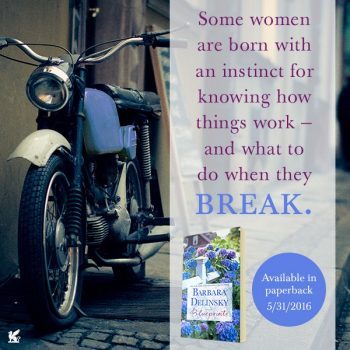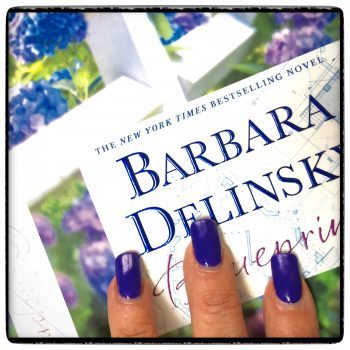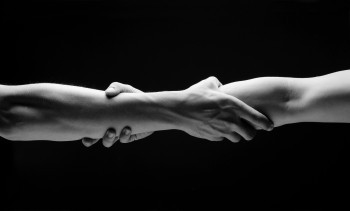Barbara Delinsky's Blog, page 5
May 29, 2016
Why I included what I did in BLUEPRINTS
With Blueprints going on sale in paperback this week, I just reread it to refresh my memory. Does it surprise you that I would need to do that? But consider this. I’ve written and published more than 80 books. No human mind can keep straight all the details of 80 books. Moreover, it’s been two years since I finished writing Blueprints, and since then, I’ve been immersed in writing The Make Up Artist. I’ve often made the analogy that moving from book to book is like cramming for final exams. You jam as much as you possibly can into your mind, take the exam, then push it all out to make room for the next subject.
The neat thing is that I came back to Blueprints with a fresh mind. Naturally, I loved it – of course, I loved it. I create people I love, use settings I love, add elements I love. This time, though, I found myself wondering why I do love these things. So here’s a breakdown.
A wonderful, old Victorian house plays a role in Blueprints. Why? Because I grew up in a large Georgian colonial but always coveted the Victorian of a friend. The walk from my house to the high school took me down a street lined with beautiful Victorians, and my friend’s was the best of the lot. I loved its front porch, its tiered layout, its meandering stairs and the nooks and crannies between.
Carpentry plays a role in Blueprints. Why? Because good carpentry is a thing to behold. Seriously. I’ve always been in awe of the people who do it. They are artists. When it comes to the men among them, some are tall and sinewy – i.e., gorgeous. Way back, I wrote a book called The Carpenter’s Lady, the first line of which was, “From the waist down he was promising.” Enough said.
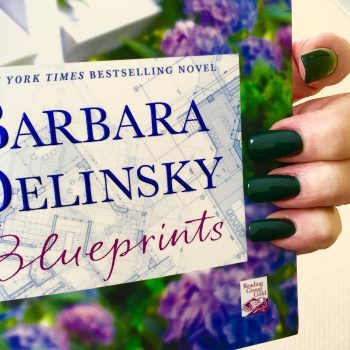 Nail polish plays a role in Blueprints, along with grapefruit and thyme body cream. Why? Because I’m into both. The body cream I use is by Stonewall Kitchen. And the nail polish? Usually either OPI or Essie, and lately in shades of blue or green. Oh yes, I’m a color person. Just like Caroline.
Nail polish plays a role in Blueprints, along with grapefruit and thyme body cream. Why? Because I’m into both. The body cream I use is by Stonewall Kitchen. And the nail polish? Usually either OPI or Essie, and lately in shades of blue or green. Oh yes, I’m a color person. Just like Caroline.
Cats play a role in Blueprints. Why? Because my own cat has been dead for five years now, and I miss her terribly. Writing about Caroline’s three cats brought me a purring comfort.
Heirloom lace plays a role in Blueprints. Why? Because I have few heirlooms from my past and regret that. So I live vicariously in this, too.
And then come motorcycles. Caroline’s love-hate of them reflects my own. The first time I was ever on a motorcycle, I was in college, sitting snug up against a guy whose name I remember clear as day – but since I have no idea what he’s done with his life, where he is now, even whether he’s still alive, his identity will remain secret. Suffice it to say that the ride was exhilarating at the time, if terrifying both before and after.
I could go on and on here. There’s so much of me in every book. Who has questions?
May 4, 2016
Why I’m not retiring
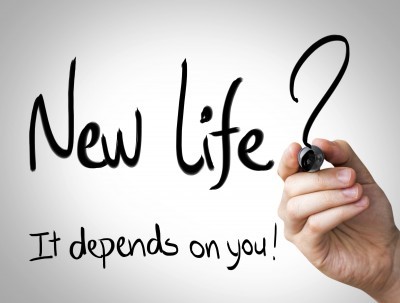
A reader just wrote that she heard I was retiring. Who said that?
No. I’m not retiring. Let’s be clear about it. I. Am. Not. Retiring.
Not that I haven’t considered it in moments of frustration. Life for a writer has changed. When I started – more than 30 years ago – all I had to do was write. Ha ha. That’s funny. I was a full-time mother of three young sons, a full-time wife, a full-time homemaker. And all I had to do was write.
Consider it, though. A mother’s work is often mindless. Crucial. But mindless. Folding laundry? Driving car pool? Making school lunches. Cooking every other meal. Waiting at the doctor’s office, the dentist’s office, the hair dresser? Supervising play in the back yard? Physical presence is required in these things, far more than intellectual presence.
Writing filled that void. It was an ideal escape for me at a time when I was wondering why in the devil I got a bachelor’s degree, why in the devil I got a master’s degree, if my destiny in life was to match socks. I set my mind to plot and character development, and when the kids were in school, I wrote. It was very simple. The most challenging times were when I had to choose clothes – and make arrangements for my absence at home – in advance of a two-week author tour.
Enter computers, e-mail, the Internet, and social media. Suddenly I had to create a website and keep it current. I had to answer email from readers – well, I didn’t have to, not all writers do, but my readers are important enough to me to want to answer each note. I had to write blogs and reading group discussion questions and promo materials. Like email arriving at 10 at night, the work seemed to be never done. It was, frankly, exhausting.
So I took a little break. This was last June, was right after Blueprints was published. I had put off signing a new contract, because I didn’t want a deadline. I had already written a proposal for my next book, The Make Up Artist, and had even written the first three chapters. I put it all aside and did nothing for eight months.
Actually, not nothing. My days were full. If I wasn’t meeting a friend for lunch, I was playing tennis or spending time with my kids or learning Spanish or knitting or reading. It was kind of nice getting up in the morning and making a little list ( I’m a list person) of what I would do that day, and feeling no stress at all.
After a few months, though, a funny thing happened. I started thinking of The Make Up Artist more and more. The characters remained vivid, and I missed them. I missed the writing itself. I even missed the discipline that came with having a contract, discipline which in turn gave structure to my day.
I did not miss the deadlines or the pressure or the gazillion chores that came with being a writer in 2016. So I restructured things. I gave my agent the go-ahead to negotiate a contract for The Make Up Artist and a second book, but the deadlines are more generous than I will ever need, hence no pressure. I set the goal of two pages a day for myself – a far cry from the ten pages a day I consistently wrote, or tried to write and failed – two pages or three hours, whichever comes first. I put limits on what I am willing to do where social media is concerned. LinkedIn? Nope. Snapchat? Pinterest? Too much. I do Facebook and Instagram, and I do them well. Enough said.
So. I’ve taken control of my writing life. I will not retire because (a) I have too many good ideas to write about, (b) I love the art and craft of writing, (c) writing is my identity, the scaffolding that keeps my life in shape, (d) I love tennis and my kids and my friends, but I like having something totally apart from those, and (e) I have a cadre of loyal readers who wait for each book, and, if that’s so, why would I let them down?
Perhaps I was too driven before. Perhaps I’ve simply come to a place where I know myself better. Whatever, please trust that I am not retiring. You all will get your books, and I’ll get my writing satisfaction, and we’ll stay best of friends. Yes?
April 21, 2016
Why I just joined Instagram
 I swore I wouldn’t. Social media is only good if you do it well, but how many social media sites can one writer do well and still write her book? I’ve done Facebook for a long while and have a healthy following. For posting news, sharing events, offering contests, and simply getting the opinions of readers who matter, Facebook is my go-to site.
I swore I wouldn’t. Social media is only good if you do it well, but how many social media sites can one writer do well and still write her book? I’ve done Facebook for a long while and have a healthy following. For posting news, sharing events, offering contests, and simply getting the opinions of readers who matter, Facebook is my go-to site.
So why join Instagram? Instagram is just about taking pictures, right? But pictures alone? Why would a writer do that?
Well, that’s an interesting question. Did you know that I was a photographer before I was a writer? I actually taught photography for a while – was probably a better teacher than doer, as the old saw goes, but my pictures are all still pretty good. I take a lot of them and often, meaning that my phone, iPad, and computer are packed with them. In that sense, Instagram would be right down my alley. Funny, Instagram prides itself on its filters, like its followers have never tinkered with iPhoto before. I tinker all the time. If it isn’t adding contrast to my shots, it’s enhancing saturation or highlights or definition. Whether shooting with an iPhone, a compact Leica, or a full-size Nikon with a 70-300 mm lens, I understand that what makes a picture is less the equipment than the eye of the photographer, both at the shooting and editing stages. An example:
So I knew I could post good pictures, ones with my own signature look. Still, joining Instagram wasn’t an impulsive decision. I did a ton of research, including studying other authors’ posts. Some focused on the author’s work, some focused on the author’s family, some were simply of the look-at-me-signing-my-book-in-Italy kind of thing. Some were truly artful and, in that, an inspiration.
Mind you, I didn’t find a lot of authors on Instagram. I suspect many question the purpose of it, just as I did. But the more I looked, the more intrigued I became. It struck me that Instagram isn’t simply about posting pictures of my breakfast. Well, if I were Kim Kardashian it might be. But I ain’t her. No, for me it would be about offering readers something of quality and thought that was different from what I already offer them on FB or Twitter.
So. What’s different?
For starters, my Instagram author photo is more casual and fun than the one I use on other social media sites. Same with my bio. “I eat/live/write New England” sums up my Instagram theme. I’ll be posting photos of my New England, my desk and desktop, even teasers from my books in the form of screen shots as I work. Some photos will offer writing tips, like one of the timer I use to help with self-discipline. Some will be of typically New England food, such as maple syrup, lobster, and fiddleheads.
What really makes the photos I post on Instagram different, though, is the personal angle. That is MY computer you’ll be seeing, MY desk, MY colander with the fiddleheads I just bought at the market. Those are MY blue fingernails on the BLUEPRINTS cover I just received, MY grandchildren with me in VT. Yes, that screen shot of my manuscript is taken from what I wrote just moments ago.
Does it sound (and look) like I’m having fun? Well, that’s the bottom line. I am. I’m using my art eye again and having a good time of it. I’m at instagram.com/barbaradelinsky. Take a look and see what you think.
Not on Instagram? Perhaps a daughter or friend might check it out on your behalf, even follow me so that she can keep you apprised of new posts. Oh, and if you know of an author on Instagram, I’d love to follow him or her, if only in support of our field.
Another request? I know I’m supposed to set up hashtags, so I came up with #bdbooks, #read2escape, and #write2escape. But I’m still trying to figure out how, when, and why to use them. Help!
Do you do Instagram? If so, why? What do you get out of it? How often do you check it? What inspires a “like”? Any and all tips are welcome, here. I’m still a total novice!
April 7, 2016
Walking on thin ice

I have three sons. All are grown, married with kids, and gainfully employed. They genuinely like me, and I genuinely like them. In all of these things, I am very, very lucky.
That said, navigating the waters with an adult child hasn’t always been easy.
First came college. Actually, the trouble began not when my guys left home, but when they returned home for things like long weekends, holiday breaks, and the summer. They wanted to go out at 10 pm and return at 2 am, which was fine and good when they were living in a dorm, but not when Mom and Dad were waiting and worrying. It took some talking to, a few slammed doors, more than a little attitude to slog past and some complex negotiating before we compromised on the idea of phone calls, a slightly earlier curfew, and the occasional night spent at a friend’s house.
Next came – ta da! – the graduate. A college degree is big stuff. But what commenced then was laziness, and I kinda, sorta understood. After applying themselves through high school to get into college, then through college to get that degree, the pressure was suddenly off. They needed downtime. They’d earned downtime. But how much? One week? One month? Two months? After that, lazing around watching daytime TV was too much for me to bear. Our oldest son claims we “kicked him out of the house,” when we forced him to put into action his post-graduation plan – i.e., to look for a job. BTW, despite his unhappiness with us and the tension it caused at the time, he now says it was the best thing we ever did.
Next in the storm of co-existing with adult children came marriage. As different as my three sons are from one another, all three pushed me away during their first year of married life. I understood that this was necessary. We had always been close, but now they had to focus on being close to their wives. And I was fine with that. Lord knew, I had enough to do in my own life not to micromanage theirs. Besides, they did come back, perhaps not all the way, but in a way that was appropriate and comfortable all around. What I learned during this rocky stretch, though, was that I had to take my lead from them. Relationships change. My kids were grown up. The more I pushed myself into their lives, the more they would have to push me away. I had to give them space – which was actually good preparation for their next step
Parenthood. This is where we are now. I do have to say that being a grandparent is a joy. My mother died young and never saw her three daughters as teenagers, much less married with kids. How fortunate I am that I have! My career is a help in this regard, too. It gives me purpose apart from the grandchildren, so that my life doesn’t depend on theirs.
Here, though, the tricky part really kicks in, because there are rules.
Rule #1. Keep your mouth shut. Times have changed. Child-rearing is very different today from it was 30 years ago.
Rule #2. Keep your mouth shut. Unless someone asks for your opinion, do not offer it.
Rule #3. Keep your mouth shut. Unless you see serious harm being done to a grandchild, you have to let the parents do the parenting. Sure, they may make a few mistakes, but unless those mistakes are catastrophic, the kids will survive.
As I said at the start, I’m the mother of sons. That immediately colors all of the above. My sons do change diapers. They do help around the house. Still, their wives are the leaders when it comes to child care. For that reason – and because the older I get, the more I miss having had a daughter – I’ve worked hard to create an open and honest relationship with my daughters-in-law. I don’t criticize the way they cook, keep house, or dress the kids. When asked my opinion, I give it gently. If they disagree, I let it go. I do not offer criticism. A major rule here? I never complain to one of my sons about something his wife has done. The fact is, if I make my sons choose between mom and wife, mom will lose.
Is it easier for mothers of girls? I’m sure that depends on the nature of the mother-daughter relationship up to that point.
One thing is for sure. I agree with a wise friend who kept a sign on her mirror that read, “You had your turn. Now it’s theirs.”
Let me repeat, here and now, that I am lucky – and I’m knocking wood as I type this. My family hasn’t had the major health issues that can strangle lives. We haven’t had alcohol or drug problems. Our jobs have held steady; we’ve remained economically secure. Some of you reading this haven’t been as fortunate, and I feel for you. If, for instance, one of my boys had had serious problems, I’d be writing a very different blog.
Still, despite the different experiences we may have had with adult children, I’d guess that you and I share bits of the frustration, the hurt, even the anger or loss that comes when a child grows up. Do they ever truly leave the nest? I’m not so sure. That’s what walking on eggshells – a.k.a. thin ice – is about.
What are your thoughts here? Feel free to post a comment below or, better still, join the ongoing discussion at my website. Know who’s been posting? Caroline MacAfee, from BLUEPRINTS. Join her!
February 16, 2016
Lean on me
Lean on me… when you’re not strong …
Remember that song? Bill Withers wrote it in 1972, which may have been the year you were born, or the year your children were born, or ten years before that, but the words are timeless. I’ve been thinking about them a lot.
I don’t have many close friends. All these years being a wife, mother, and writer, I never had time for friends. Now I do. There are things I want to discuss, and there are things I want to discuss with other women that only women will understand. But how to find good friends at this stage?
A major issue for me, and I think for most of us, is trust. How do I know that if I share something personal it won’t be batted around on social media the next day? Social media scares the heebie-jeebies out of me. I’m a private person. And proud. I don’t want to be ridiculed, and I want what I share with a friend to remain between friends.
I had a wonderful introduction to this last fall when I joined a group of women for a week on a one-house island. We talked about everything, trusting that what was said on the island stayed on the island. That element of trust required a leap of faith, both on the part of our hostess, who personally invited each of us there, and the seven other women who opened their minds and hearts to make it work.
Our hostess, the friend who trusted me enough to ask me along, set a courageous example. So I’m throwing my own island getaway of sorts, a virtual gathering on my website. You readers chose the name last fall – Hear Me Roar – and it’s for women who are strong or want to be, but need a boost.
I just might have a problem that you’ll understand, we all need somebody to lean on …
That’s the premise. But I need your help. What do you want to discuss? What most concerns you on a personal level? My readers are caring, smart, trustworthy women, and my website isn’t set up to go viral, making it isolated, much like an island. So what topic would lure you to this island?
This isn’t a contest, just me asking you to help pick the first subjects on the Hear Me Roar discussion board. Please tell me your choices either in a comment to this blog, through a Contact message, or, best of all, on the discussion board itself, where you’ll find a forum called What do you want to discuss?
Talk soon!
February 10, 2016
Do you multi-task?
 More aptly, can you multi-task? Some people can’t. Some do it now and then. Some are able but unwilling. Where do you fall on the spectrum?
More aptly, can you multi-task? Some people can’t. Some do it now and then. Some are able but unwilling. Where do you fall on the spectrum?
I’m of the able-but-unwilling school. I used to multi-task more than I do now, and age has something to do with that. But it’s a positive thing. I’m wiser now. I choose now to multi-task less. That said, it’s taken me a while to get to this point.
I’ve always maintained that women are better able to multi-task than men. I swear it’s in the genes – right along with the ability to mother a child. Not all women have children, but they’re born with the tools to do it. Same with multi-tasking, because being a mother requires that. Children don’t wait patiently while their mothers finish other tasks. What they need, they need now. Same with the other jobs a woman does. Those jobs make time demands, too, and the only way to get it all done is to do more than one thing at once. We can do that. We can do it well.
Much has been made of women with outside jobs who still do the bulk of the work at home. I like to think this is slowly starting to change. My sons all cook and help out with child care; I’m sure many men now do. But still, when a child is sick, women are the ones who most often stay home. Yes, our career paths may take a hit, but isn’t it a tribute to us that we do it anyway?
All too soon the kids grow up. My first empty-nest year, I would stand in the kitchen at the end of the day trying to think what I was supposed to do. The idea that I could actually relax and take a few minutes for me was foreign. Oh, I got used to it. I would read or knit and watch the news until it was time to make dinner, and then, while dinner was cooking, I folded laundry or talked on the phone or payed bills. So I was still the multi-tasker, albeit with fewer tasks to multi.
Then I found that it was pleasant to watch tv without knitting at the same time.
And that it was nice to be able to talk on the phone without having to fold laundry at the same time.
And that my taste buds didn’t want a dozen flavors, but craved “clean” food (like the grilled steak in the photo above).
Oh, I still multi-task. Just like when my kids were little, there are times when I have no choice. Increasingly, though, there are times when I do have a choice, and, in those times, I opt for purity of experience.
How about you?
January 13, 2016
Post-Its keep me sane

“That’s the best thing since …” How do YOU finish this sentence? When I was growing up, the answer was sliced bread. When I was raising my own kids, the answer was bagged lettuce. Now, it’s Post-Its. At least, in my humble opinion.
That’s because I’m a list keeper. Rarely does a day go by when I haven’t made one list or another. Studies show that people who keep lists are more productive. I do think that’s true for me, and for four reasons.
First, a to-do list helps me prioritize my day. And if my list isn’t prioritized simply by the order of items on it, I use asterisks to mark the most important ones.
Second, if I have a list, I won’t forget something. I read once that if worries keep you awake, you should write each worry on a piece of paper, put it in a “worry box,” and therein let go of the worry enough to fall asleep. A to-do list gives me a similar release. With a list beside me, I can focus on getting things done rather than on trying to remember what’s on the list.
Third, a list motivates me to act. Enough said there.
And fourth, there’s the sense of accomplishment that comes from crossing each item off the list.
Ok, you list-makers. A list is a list, regardless of where it’s written. Right? And regular paper, or scrap paper, even a supermarket receipt is good, too. Right? But Post-Its are better – again, in my humble opinion – largely because they stick places where you can actually see them. After all, what’s the point of a reminder if you can’t find it?
I have Post-Its in different colors – yellow, pink, green, purple and blue. Personally, I prefer the lighter colors. My blue pen stands out better, for instance, on yellow or pale green.
I have them in different sizes, tiny to large. My most-frequently-used size is 3 X 5, which seems to work best with the lists I make.
I have them in different shapes. For work, I want a more serious square or rectangular. For personal things – a list of, say, Valentines Day cards to buy – I branch out. An apple, a telephone, an arrow, a heart – I have them all.
Where do I stick them? If my list is strictly related to work, the Post-It goes on my computer. If there are non-work things mixed in, the Post-It goes on the corner of my desk. If the items are wholly non-work, the Post-It goes on the kitchen table downstairs. And the reminder of a crucial appointment, meeting, or tennis lesson? That is written with a thick sharpie, so that it can be seen a dozen feet away, and is either stuck on the wall at the top of the stairs or on the door to the garage.
Did you know that Post-Its were created by accident in a totally unexpected moment? Actually, two such moments according to the history I just read. One occurred in 1968, the other in 1973. The first attempt at sales failed largely because of poor marketing, but someone believed in the cause enough to persist.
I’m so glad they did. Post-Its are every bit as crucial to me as bagged lettuce and sliced bread – though I do admit to having taken a liking lately to fresh-baked, unsliced bread. But that’s for another blog.
What’s your life-saver?
January 8, 2016
New Year’s resolutions gone wrong
Broken them already, have you? Personally, I can’t count the number of years I vowed to diet, only to pig out within days of the holiday. New Year’s resolutions are tricky that way. Too often we set ourselves up for failure with yet another promise to work out or quit smoking or limit screen time.
There are many reasons for failure. Some are valid. Others, not so.

Take genes. Here’s the rationale. Our genes are to blame. There’s nothing we can do. If we’re genetically prone to being overweight, why try to stick to a diet? And exercise? If our parents were couch potatoes by nature, we will be, too, right? Why quit drinking, if addictive behavior runs in the family. Heck, why try to be nicer to others, if we come from generations of people with attitude?
Do I believe the above? No. If you’ve read my books, you know that. I see the glass as half full. My books, my characters, my life are about growth. I refuse to accept that a person is doomed by her genes. I inherited breast cancer. But because I had regular mammograms, my own breast cancer was caught early enough to cure it.
In fairness, that has to do with medical advances. Some genetic factors are more dicey. Studies have shown, for instance, that parents prone to addiction often have children with the same genetic predisposition. But doesn’t the example we see also feed into our behavior? If we see a parent dealing with stress by finding fault with everyone in sight, don’t we learn to deal with stress the same way?
It’s the old nature versus nurture debate. Is our behavior inherited or learned? What do you say? Me, I say a little of both. A child may be born with the same volatility as one of his parents, but she can also be taught awareness and self-control.
Alcoholism, diabetes, and heart health all have genetic components. But we may be able to make many of these cases better by our own lifestyle choices.
But we have to want to do it. Breaking bad habits is hard work. We can blame our genes until the cows come home, but at what point is bad behavior simply … bad behavior? At what point do we need to take responsibility for our actions? At what point does TAKING RESPONSIBILITY become the best New Year’s resolution?
December 2, 2015
Sleep habits of the grudgingly mature
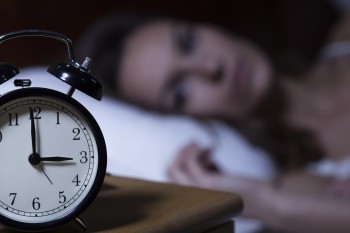
Here’s a pressing question: Does the need to pee wake us up, or do we wake up for another reason entirely and then decide to pee?
And another one: Do we wake up early because our eyelids have thinned out so that even the first light of dawn penetrates, or do we wake up early because we went to bed early?
I’ve always been a morning person. I’m out of bed at dawn because I crave a cup of tea, because my mind is fresh and eager to work, and because I go to bed early after waking up early, so the cycle goes.
Actually, I wasn’t always an early-morning person. It began when I became a mother, when the day started with the rising sun, when I learned to sleep less deeply to keep one ear tuned to the night sounds of my kids, when I couldn’t obsess over a broken night’s sleep because the next day’s needs were at my bedside, shaking my arm, wanting breakfast.
And anyway, what’s with the eight-hour dictate? Historically, it dates back to the Industrial Revolution, when Conventional Wisdom divided a 24-hour day into equal thirds for work, rest, and sleep. But do we really need those full eight hours? Recent studies state that seven hours work just fine for most people, even six for some of us as we get older. And if those hours are broken up, four and three, or three and two and two, that’s okay, too.
I just tested this out. We had been planning to travel this Thanksgiving and eat, with family, at our very favorite inn in Woodstock, Vermont. At the last minute, our plans had to change. I learned this Monday afternoon at 4 and was at my local supermarket at 7:15 Tuesday morning – because if we don’t go away, guess who hosts? I’m ready to pass that torch, let me tell you, but there’s a whole other blog. For now, suffice it to say that I wasn’t a happy camper slogging through the supermarket, and once the food was stashed in my fridge, I refused to give it another thought. My Wednesday was relaxed – a little work, a little tennis, a little reading, dinner out with my husband. I think I wanted to pretend, for as long as possible, that we were still going away.
That little fantasy lasted until 2 AM on Thanksgiving day, when I woke up after four hours of sleep and realized that, other than buying food, I hadn’t done one thing. Not. One. Thing. Granted, there would only be 8 of us. Still, I would normally have pre-cooked things like squash bisque, stuffing, cornbread, apple crumble, and mulled cider. I might have even made the salad and covered it tightly. None of that this year.
Realizing this, I had a mini-panic. Knowing I would never fall back to sleep then, I got out of bed and set my 2 AM table – good china and silver, water glasses, wine glasses, candles, linen napkins pulled through ribbon rings, serving plates set nearby. When I returned to bed an hour later, I was tired again but satisfied. I fell asleep for another three hours. Thanksgiving Day was wonderful, and I was no more tired than anyone else by its end.
I wasn’t thinking of being tired, therefore I wasn’t tired. For me, there’s definitely a psychological element to it. Another recent example? After a night of broken sleep because I was anticipating taking an early flight to visit one of my sons, I got out of bed at four-thirty to shower, pack, and head to the airport. Debarking at the end of the flight, I hit the ground running and was busy all day, but didn’t think of being tired until later that night, when everyone else was tired, too.
Bottom line? When physical energy lags in we grudgingly mature, mental energy can give it a boost. My sleep may not be as smooth now as it was a decade or two ago. But the more agitated I grow about waking up, the more trouble I have falling back to sleep. That’s why I love the idea of embracing insomnia. Occasionally, I sleep badly, totaling only four or five hours. If I get out of bed convinced I’m in for a bad day, I am. Conversely, if I get out of bed telling myself I’m just fine, I am. A mid-afternoon nap is nice. If that isn’t possible, though, no sweat. I simply tell myself that I’ll sleep the next night. And I do.
I’m simplifying this, of course. There are scientific reasons, both physical and psychological, for poor sleep. Sleep apnea is one, but there are others that are just as troubling. If you suffer from one of those, I feel for you.
Blessedly, I only suffer from age. How about you? How do you sleep now, compared with how you slept 20 years ago? What wakes you up? Is your daily functioning affected by how much you sleep on a given night? And if you do embrace insomnia and climb out of bed, do you read? Fold laundry? Do crossword puzzles?
October 20, 2015
BD read these books, too!
Last week was for audio, but here are three books I recently read in the flesh, as so many of you choose to do as well. Audio or print, the stories remain the same. If something in one of these books appeals to you and you’re an audiobook person, by all means, listen.
First, The Marriage of Opposites, by Alice Hoffman.

I have loved Alice Hoffman’s books for years, and “The Marriage of Opposites” didn’t entirely disappoint. Her portrayal of setting is exquisite – in this case, St. Thomas in the first half of the 1800’s, then Paris. Her imagery is vivid, and her research through. I have no doubt but that the historical detail offered in “The Marriage of Opposites” is accurate.
Truly, though, I learned more about the scenery that may have inspired the artist, Camille Pizzarro, than about the artist himself – or any of the other characters, for that matter. The story seemed to float along on a beautiful surface without ever quite dipping beneath. I felt that the author told me her story, rather than letting me live it myself. The characters felt flat and two-dimensional. I never truly got inside them.
And then, when the artist’s mother, Rachel, whose voice is the most prominent in the book, grew unreasonably bitter, the charm I usually feel while reading Hoffman’s books was lost. Even the magical elements in this book felt superimposed.
That said, I deeply admire Alice Hoffman as a writer. This book may not have resonated with me, but so many of her other books have that I will buy her again without doubt.
Second, Circling the Sun, by Paula McLain.
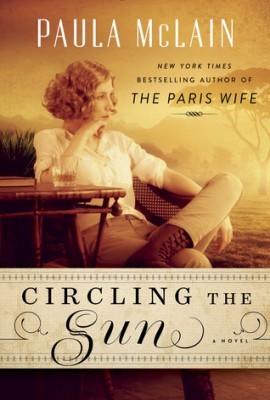
After so much praise for her last novel, “The Paris Wife,” it must have been daunting for this author to approach a follow-up. The woman she chose to chronicle this time around, Beryl Markham, was the first woman ever to fly solo from England to North America, though this is a surprisingly small part of the book. The bulk of it details her childhood in what would become Kenya, her growing up years as a fiercely independent woman in a male-dominated world, and her endless bid for freedom.
“Circling the Sun” is one of the most lyrically descriptive books I’ve read lately, which is one of the reasons I was desperate to adore it. But I didn’t. Much as I loved the style, I was increasingly frustrated with the pacing, organization, and the search for a point to the book.
The main character was prone to making poor decisions, impulsive decisions. She was scattered in matters of the heart – loving one thing, then another and another, perhaps all in compensation for her mother’s desertion when she was four. By the time she got to flying, I felt she was simply running away. Yes, through the book she seeks freedom, which flying embodies. But with so little here about her actually experience in a plane, flying seemed like just another distraction.
Paula McLain certainly couldn’t change Beryl Markham’s life. But I wish she had been more focused in her retelling of it. And then there’s the title. Does it mean that Beryl is always in orbit, as in, on the move? Or that she is destined to always revolve around bigger and brighter things? Or does it relate to flight (though her solo flight was portrayed as being wholly in the dark)? This was unclear. At the end, like Beryl, I felt unfulfilled. Perhaps this is what the author intended.
Finally, Americanah, by Chimamanda Ngozi Adichie

I struggled with this book. When it first came out, I picked it up more than once after hearing buzz about it, but something held me off. Then my book group picked it for discussion, and I had no excuse. My initial hesitance lingered, then grew through the reading, and though we had an amazing book group discussion, nothing was said that changed my mind.
Strong points? Characterization. There were wonderfully rich side characters. And places. Scenes in the hair braiding shop in New Jersey were clear and poignant. This book makes hair into a symbol, and I do see that, though whether it’s a race thing, a class thing, or simply a style thing, I’m not sure. Hair care is a huge commercial enterprise, not just in New Jersey or in Nigeria, but worldwide, and seeing it through Adichie’s eyes was enlightening.
There were some other wonderfully insightful moments here, any one of which might have formed the core of this book, had they not been so quickly passed by.
That, for me, was the problem This book was all over the place — not quite a memoir, not quite a novel, not quite a blog. By the author’s own admission, the story was semi-autobiographical. And the main character does have an awful time as she goes from Nigeria to America and back. But nothing about her engaged me. Nothing about her evoked compassion. She was her own worst enemy, making one bad decision after another, sabotaging her own happiness and hurting others. Yes, she encountered racism. But she too often blames it for things that may, indeed, be simple facts of life.
The author gave a TED talk about the danger of hearing only one story. In this book, she tells only one story. I’m sorry for that. She is articulate and has talent as a writer. I simply wish it were better directed.
There you have it, three more books to consider. Interesting, that the three I reviewed two weeks ago, all of which I heard in audiobook, worked better for me. Is that because the narrator added something that was lacking in print? This is something to discuss.


